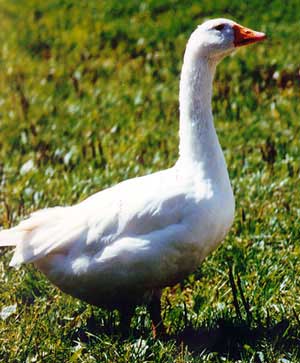Diepholz Geese
 The Diepholz Goose comes from Northern Germany, from the county named Diepholz. It
has been bred there for the last 100 years. In 1925 the Diepholz Goose was recognized
as a breed. This goose is in build and appearance closely related to the Gray Goose.
The Diepholz Goose comes from Northern Germany, from the county named Diepholz. It
has been bred there for the last 100 years. In 1925 the Diepholz Goose was recognized
as a breed. This goose is in build and appearance closely related to the Gray Goose.
Geese as Domestic Animals
In earlier cultures geese were kept as offering animals, additionally as sources of meat. The feathers were used for writing purposes and the down for pillows and covers. Because geese had to make their way from the producers to the consumers on foot, light country varieties were bred most of all. In the 20th century a writing instrument came out of industrialization which replaced the goose quill. In addition, as fill material more and more artificial products were utilized. Changes in eating habits led in the same way to a reduced demand. Goose keeping lost more and more in significance. The prerequisites were set for a gradual disappearance of the large flocks. Today in many places only pairs or small flocks are kept.
Characteristics
Of the recognized breeds present today, the Diepholz Goose fulfills the requirements which are characteristic of a light country goose. It is only 5 to 7 kg in weight, thereby very surefooted, in respect to grazing very undemanding (it also eats sour grasses), early maturing and lays the majority of its eggs between September and March. It reproduces on its own without artificial intervention. Its brooding instinct is excellent, and it has a distinctive need for brooding, and it is considered a good leader of goslings. A particular feature is its outstanding fullness of flesh in the valuable parts, the breast and the thighs. It is a lean goose and provides lean, muscularly firm and at the same time tender meat.
Distribution in Switzerland
The animals known to us are for the most part in the German-speaking areas. Up to now a good 200 animals have been ringed; as many uncounted animals are located likewise in this part of Switzerland. Since 1995 the ringed animals have been entered in the Flock (Record) Book.
References
Endangered Domestic Animal Breeds 1995, Pro Specie Rara, Engelgasse 12a, CH-9000 St. Gallen, Switzerland, Telefon 071/222 74 20, Fax 071/223 74 01. German Translation provided by John te Velde, Associate Professor of German, Oklahoma State University
